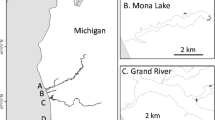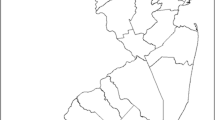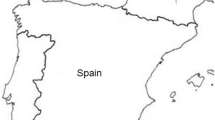Abstract
Organochlorine contaminant levels were measured in 78 adult snapping turtles collected from 16 sites in southern Ontario, Canada in 1988/89 to evaluate the risk to humans of consuming snapping turtles. Significant differences in turtle contaminant levels were observed among sites. Mean levels in muscle, at all sites, were below fish consumption guidelines for total polychlorobiphenyls (PCBs), total DDT and mirex. However, contaminant levels in older turtles from some sites exceeded guideline values. Multivariate statistical techniques indicated the existence of a highly significant relationship between contaminant levels in adult female turtles and their eggs. Multivariate techniques also identified differences in contaminant composition in adult snapping turtles from sites in the Great Lakes where differences in reproductive success have been previously observed. The mono-ortho substituted PCB congener 2,3,4,3′,4′-pentachlorobiphenyl (IUPAC #105) may be an important contributor to the toxic burden of snapping turtle populations.
Similar content being viewed by others
References
Alexander MM (1943) Food habits of the snapping turtle in Connecticut. J Wildl Manage 7:278–282
Ballschmiter K, Zell M (1980) Analysis of polychlorinated biphenyls (PCBs) by glass capillary gas chromatography. Composition of technical Aroclor®- and Clophen®-PCB mixtures. Fresenius Z Anal Chem 302:20–31
Bryan AM, Olafsson PG, Stone WB (1987) Disposition of low and high environmental concentrations of PCBs in snapping turtle tissues. Bull Environ Contam Toxicol 38:1000–1005
Burger J (1992) Trace element levels in pine snake hatchlings: Tissue and temporal differences. Arch Environ Contam Toxicol 22:209–213
Canadian Wildlife Service (1987) Analysis of organochlorine hydrocarbons in tissue samples. In: Environment Canada Analytical Manual. Ottawa, Ontario, Canada
Conant R (1975) A field guide to reptiles and amphibians of eastern and central North America. Houghton Mifflin, Boston, MA, p 429
Connolly JP, Pederson CJ (1988) A thermodynamic-based evaluation of organic chemical accumulation in aquatic organisms. Environ Sci Technol 22:99–103
Coulter MW (1957) Predation by snapping turtles upon aquatic birds in Maine marshes. J Wildl Manage 21:17–20
Digby PGN, Kempton RA (1987) Multivariate analysis of ecological communities. Chapman and Hall, London, p 206
Environment Canada (1991) Toxic chemicals in the Great Lakes and associated effects. Vols 1–2. Ministry of Supply and Services, Ottawa, Ontario, Canada
Froom B (1975) Ontario Turtles. Ontario Ministry of Natural Resources, Toronto, Ontario, Canada, p 25
Galbraith DA (1986) Age estimates, survival, growth, and maturity of male,Chelydra serpentina Linnaeus, in Algonquin Provincial Park, Ont. MSc Thesis, University of Guelph, Ontario, Canada
Gower JC (1966) Some distance properties of latent root and vector methods used in multivariate analysis. Biometrika 53:325–338
Hall RJ, Kaiser TE, Robertson WB, Patty PC (1979) Organochlorine residues in eggs of the endangered American crocodile (Crocodylus acutus). Bull Environ Contam Toxicol 23:87–90
Hammer DA (1969) Parameters of a marsh snapping turtle population LaCreek Refuge South Dakota. J Wildl Manage 33:995–1005
Jackson DA, Somers KM (1989) Are probability estimates for the permutation model of Mantel's test stable? Can J Zool 67: 766–769
Karichkoff SW, Brown DS, Scott TA (1979) Sorption of hydrophobic pollutants on natural sediments. Water Res 13:241–248
Keenleyside KA (1992) Elemental composition of vertebral bone of the northern redbelly dace (Phoxinus eos) in relation to lake environmental factors. MSc thesis, University of Toronto, Ontario, Canada
Kubiak TJ, Harris HJ, Smith LM, Schwartz TR, Stalling DL, Trick JA, Sileo L, Docherty DE, Erdman TC (1989) Microcontaminants and reproductive impairment of the Forster's tern on Green Bay, Lake Michigan-1983. Arch Environ Contam Toxicol 18: 706–727
Lagler KF (1943) Food habits and economic relations of the turtles of Michigan with special reference to fish management. American Midland Naturalist 29:257–312
Lamb T, Bickham JW, Gibbons JW, Smolen MJ, McDowell S (1991) Genetic damage in a population of slider turtles (Trachemys scripta) inhabiting a radioactive reservoir. Arch Environ Contam Toxicol 20:138–142
Lassiter RR, Hallam TG (1990) Survival of the fattest: Implications for acute effects of lipophilic chemicals on aquatic populations. Environ Toxicol Chem 9:585–595
Lovisek J (1982) An investigation of the harvesting of turtles in Ontario. Ontario, Ministry of Natural Resources unpubl. report. Toronto, Ontario, Canada, p 84
Mantel NA (1967) The detection of disease clustering and a generalized regression approach. Cancer Res 27:209–220
Niimi AJ, Oliver BG (1989) Assessment of relative toxicity of chlorinated dibenzo-p-dioxins, dibenzofurans, and biphenyls in Lake Ontario salmonids to mammalian systems using toxic equivalent factors (TEF). Chemosphere 18:1413–1423
Obbard ME, Brooks RJ (1981) A radio-elemetry and mark recapture study of activity in the common snapping turtle,Chelydra serpentina. Copeia 3:630–637
Olafsson PG, Bryan AM, Bush B, Stone W (1983) Snapping turtle-a biological screen for PCB's. Chemosphere 12:1525–1532
Olafsson PG, Bryan AM, Stone W (1987) Specific PCB congener analysis: a critical evaluation of toxic levels in biota. Chemosphere 16:2585–2593
Oliver BG (1984) Uptake of chlorinated organics from anthropogenically contaminated sediments by oligochaete worms. Can J Fish Aquat Sci 41:878–883
— (1987) Bio-uptake of chlorinated hydrocarbons from laboratory-spiked and field sediments by oligochaete worms. Environ Sci Technol 21:785–790
Oliver BG, Niimi AJ (1988) Trophodynamic analysis of polychlorinated biphenyl congeners and other chlorinated hydrocarbons in the Lake Ontario ecosystem. Environ Sci Technol 22:388–397
Reynoldson TB (1987) Interactions between sediment contaminants and benthic organisms. Hydrobiologia 149:53–66
Ryan JJ, Lau BP-Y, Hardy JA (1986) 2,3,7,8-Tetrachlorodibenzo-p-dioxin and related dioxins and furans in snapping turtle (Chelydra serpentina) tissues from the upper St. Lawrence River. Chemosphere 15:537–548
Safe S (1984) Polychlorinated biphenyls (PCBs) and polybrominated biphenyls (PBBs): Biochemistry, toxicology, and mechanism of action. CRC Crit Rev Toxicol 13:319–395
— (1987) Determination of 2,3,7,8-TCDD toxic equivalent factors (TEFs): Support for the use of thein vitro AHH induction assay. Chemosphere 16:791–802
Stone WB, Kiviat E, Butkas SA (1980) Toxicants in snapping turtles. New York Fish and Game J 27:39–50
Stoneburner DL, Nicora MN, Bloud ER (1980) Heavy metals in loggerhead sea turtle eggs (Caretta caretta): Evidence to support the hypotheses that demes exist in the Western Atlantic population. J Herpetol 14:171–175
Swackhammer DL, Armstrong DE (1987) Distribution and characterization of PCBs in Lake Michigan water. J Great Lakes Res 13:24–36
Tanabe S (1988) PCB problems in the future: Foresight from current knowledge. Environ Pollut 50:5–28
Thomann R, Connolly J (1984) Model of PCB in the Lake Michigan lake trout food chain. Environ Sci Technol 18:65–71
Watson MR, Stone WB, Okoniewski JC, Smith LM (1985) Wildlife as monitors of the movement of PCBs and other organochlorine compounds from a hazardous waste site. In: Proceedings of 1985 Northeast Fish and Wildlife Conference, May 5–8, 1985, Hartford, CT
Weller WF, Oldham MS (1988) Ontario Herpetofaunal Summary. Publ. Ont Field Herpetologists, Ontario, Canada, 221 pp
Witkowski SA, Frazier JG (1982) Heavy metals in sea turtles. Marine Pollut Bull 13:254–255
Author information
Authors and Affiliations
Rights and permissions
About this article
Cite this article
Hebert, C.E., Glooschenko, V., Haffner, G.D. et al. Organic contaminants in snapping turtle (Chelydra serpentina) populations from southern Ontario, Canada. Arch. Environ. Contam. Toxicol. 24, 35–43 (1993). https://doi.org/10.1007/BF01061087
Received:
Revised:
Issue Date:
DOI: https://doi.org/10.1007/BF01061087




